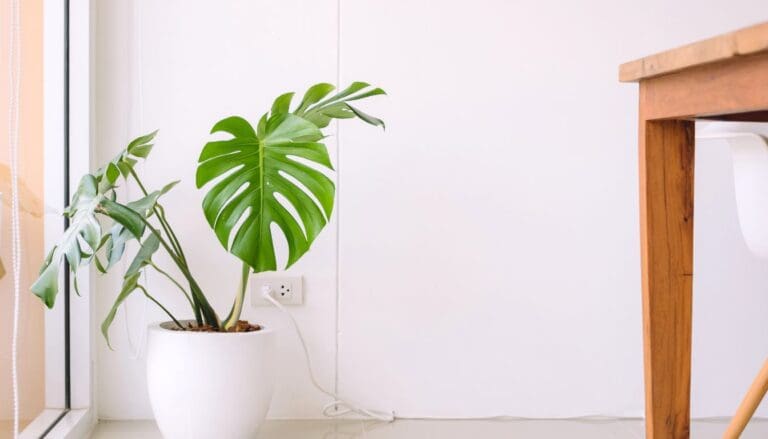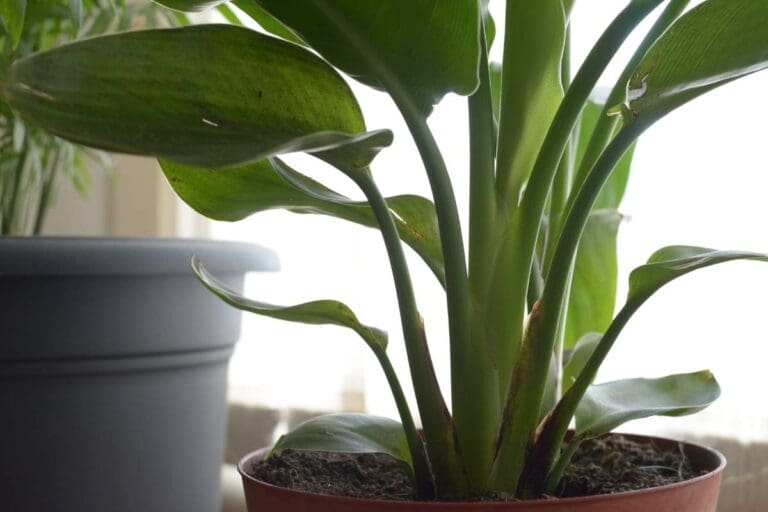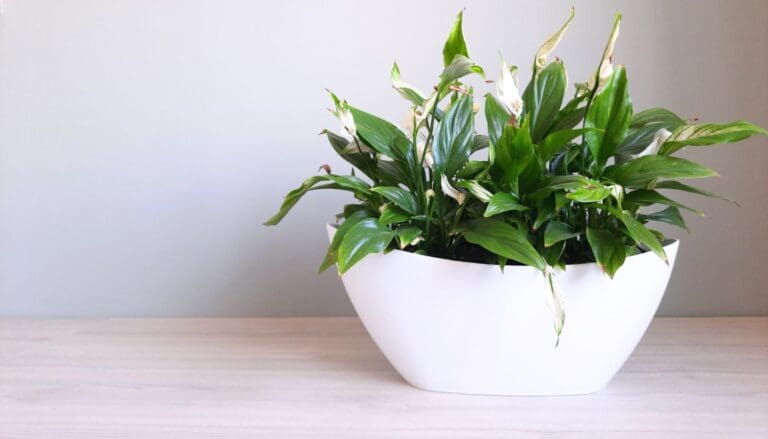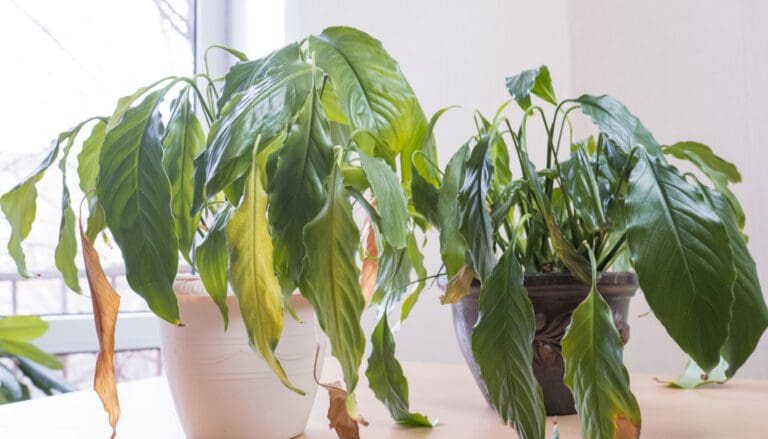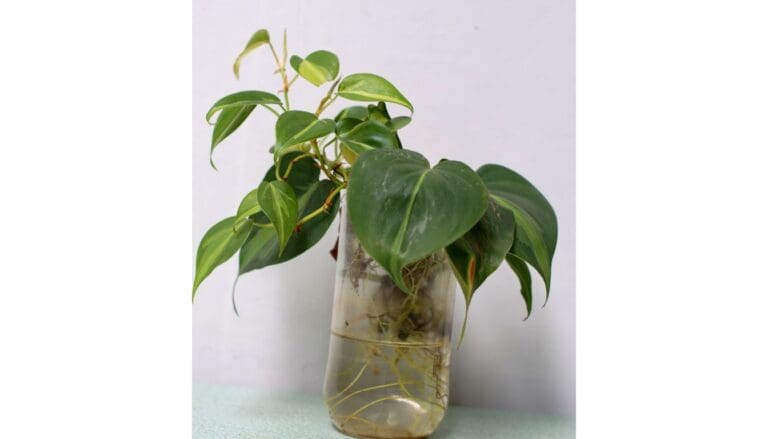How To Care For English Ivy? (Ultimate Care Guide)
English ivies are popular climbing plants grown indoors and outdoors throughout the US. They are natives to the regions around Western Europe and eastern Asia and are easy to grow and maintain. If you are planning to get an English ivy, you’ll find everything you need in this guide.
English ivies survive both in the sun and shade and enjoy soil that is slightly on the drier side. Fertilize them lightly in the growing season and maintain an average humidity of 40-50%. Their best growth occurs in temperatures within 70-90°F in loose, loamy soil that drains well.
The article will discuss all the necessary factors required for healthy, thriving English ivy, the problems the plant might face, and the solutions you can take to treat them.

Please note: Simplify Plants is reader-supported. Some links in the post are affiliate links and I get a commission from purchases made through links in the post.
English ivy overview
Hedera Helix or English Ivy originates in Europe and eastern Asia, from where they were brought to the US and got instant popularity as ornamental houseplants.
They are grown widely as ground covers, decorating fences or walls, and as hanging plants.
They are climbers and can spread quickly to cover any surface.
This is why scientists also have categorized these plants as highly invasive and capable of damaging brick walls, bigger trees, etc.
Outdoors these plants can reach a height of almost 100 feet.
They produce heart-shaped leaves that come in green, white, and yellow, and sometimes they also flower around late summer till early autumn.
Some of the common variants of the English ivy plants are:
| Variety | Identification |
|---|---|
| Glacier English ivy | It has sets of three gray-green leaves edged in silvery white hues. |
| Needlepoint | They have pointed lobed, rich green color leaves. |
| Asterisk | The glossy rich green lobed leaves are shaped like the asterisk sign. |
| Buttercup | They are pale green when kept in the shade and bright yellow color when placed in sunlight. |
| Adam ivy | They have variegated mid-green foliage with silvery white tones. |
| Fluffy ruffles ivy | These are unique ivies with a distinctive combination of green and pink ruffled leaves. |
| Gold dust ivy | They have unique golden yellow and green variegation that makes them unique. |
| Primadonna ivy | This gorgeous ivy variety has bright white variegations on dark green leaves. |
| Mint Kolibri ivy | The curly leaves have beige and white variegations on different shades of green hues on the leaves. |
| Jubilee ivy | These are compact ivies with creamy variegation on green leaves. |
Are English ivies easy to grow?
English ivies are one of the most popular plants for beginners because they are extremely easy to grow.
They look gorgeous and are hassle-free and are not finicky about most conditions, and adapt quickly to most.
However, note that although they are adaptable and low maintenance, you shouldn’t ignore or neglect them.
Providing ivies with the ideal growing conditions is important if you want them to be healthy and thriving.
Are English ivies indoor or outdoor plants?

In nature, English ivy grew in the wild from where they were brought indoors to be grown in containers.
They can survive in both ways, provided they get suitable growing conditions.
Outdoors, English ivies are grown in pots and on the ground.
Because of their invasiveness, keeping them contained in pots is recommended.
If grown on the ground, it is important that you maintain them regularly by pruning and controlling their growth.
They are comfortable in slightly cooler temperatures, and if you reside in regions where the temperature goes too extreme, you better grow them indoors.
However, ivies are still resistant plants across USDA zones 4 through 13.
If you happen to live in extremely cold areas where you experience frost, you need to bring them indoors in winters.
But they must get a suitable environment with all their requirements even while grown indoors.
English ivy care
To keep your English ivy healthy and ensure it gets all it needs, you have to understand its care needs.
So now, I will discuss all the requirements that English ivy needs to stay happy inside or outside your home.
English ivy light requirement

English ivies are adaptable to grow under diverse light conditions.
They can grow in both sun and shade, but their growth in shade will be slower than in the sun.
But the delicate leaves of ivy get scorched under the direct sun if the temperature is too hot.
Put up curtains to create a shield between harsh sunlight and your ivy.
English ivies do not do well in any extreme conditions.
If it is too hot, you need to keep it under shade; if it is very cold, the plant will need sunlight to get warmth.
You must remember that if you have a green leaf ivy, it can do fine in full shade.
But if your ivy has any variegation, it must get sufficient sunlight to maintain the colors or go pale.
Though ivies are known among the low-light surviving plants, remember they will barely survive but not flourish if the light is insufficient.
If your home does not get much natural light, install artificial lights around your ivies.
So ideally, for the best growth, keep the ivy at a spot where it gets a few hours of morning sunlight but stays protected from afternoon sunlight.
Also, rotate your plants weekly, so all sides get even light.
| Summers | Winters |
|---|---|
| Mild morning sun followed by indirect sun or shade | Full sun/partial sun |
Also read: What Kind Of Light Does English Ivy Need?
English ivy water requirement

Watering is probably the part plant growers find most challenging.
This is because it is tricky to understand the right amount of water the plant needs.
English ivies prefer drier soil which retains moisture without going bone dry.
They hate growing in wet soil so refrain from overwatering as the ivy is very sensitive and catches fungus easily.
If you are unsure about watering your ivy, use a moister meter to check the moisture content of the soil.
Also, remember to alter the watering routine as per the season.
In summers, the evaporation rate is higher.
The plant needs more water than in winters when the soil stays wet for longer due to lower temperature and lower intensity of sunlight.
In short:
- Keep the soil slightly dry.
- Do not overwater.
- Water when topsoil is dry.
Also read: How Often To Water English Ivy?
Soil requirement of English ivy

The ideal soil for your English ivy is light, loose, drains quickly, and allows a lot of air circulation.
Ivies enjoy slightly loamy soil with a pH of around 6.0-6.5.
If your soil mix gets compact and holds water for a long time, it is strictly unsuitable for your ivies.
The roots must get to breathe.
If the soil is too tight and clayey, it will hold a lot of water, suffocating the roots and leading to diseases like root rot.
If your soil is clayey and chunky, you must amend it to make it suitable for your ivy.
Here are a few recipes to get the ideal potting mix for your English ivy:
Recipe 1
- 3 parts potting soil
- 1 part vermiculite/perlite
- 1 part sand
- 1 part compost
Recipe 2
- 3 parts potting soil
- 1 part sand
- 1 part compost
- 1 part pine bark
- A handful of crushed charcoal
In short, the ideal soil for your English ivy is:
- Loamy
- Loose
- Well-draining
- pH 6-6.5
Also read: What Kind Of Soil Does English Ivy Like?
English ivy humidity requirement

Humidity around plants helps them stay hydrated and prevents them from drying up.
Unlike many tropical houseplants, English ivies do not need a lot of high humidity but do fine with an average of 40-50% humidity.
Ivies do not do well if the air around them is extremely dry.
It makes them dehydrated with yellow and droopy leaves.
So if your house has very low humidity, you need to increase it.
Luckily there are multiple ways to do that artificially, which we will discuss below.
- Misting is the most popular way to boost humidity levels though its effects are short-lived.
- A humidifier is probably the most effective way to increase humidity. It’s a device that needs to be filled with water and placed near the plants.
- You can also fill up a tray with water and put some pebbles on it and place the pot on it. The evaporated water increases humidity.
- Grouping plants together helps them to transpire and make the environment humid.
- Also, relocating the plant to a humid room like the kitchen and bathroom helps.
- Keeping aquariums near your plants also helps to keep the location humid.
In short:
- 40% humidity required.
- For humidity <40%, use a humidifier.
- Mist in summers if the ivy is outdoors.
Also read: Does English Ivy Like To Be Misted?
English ivy fertilization requirement

Periodically fertilizing your plants is necessary because as you keep watering your plant, the nutrients in the soil get washed off.
The soil gradually loses its richness and becomes infertile.
With the soil losing its nutrients, the plant begins to weaken and needs extra nutrients to bounce back.
English ivies are not heavy feeders so feeding them during the growing season is enough.
You have to be careful not to over-fertilize it as that can cause several problems like root burn, yellowing of the leaves, drooping, etc.
Also, fertilizing ivies in winters can cause huge damage as they reduce growth during this season.
The fertilizer stays unused, leading to root burn.
Resume fertilization once the warmer season arrives.
The best way and time to feed English ivies is the spring to the summer season.
You can feed it with a light liquid fertilizer every month from spring to summer and then add a slow-release fertilizer or compost once in March and once in September.
You can feed it with an NPK 20:20:20 liquid fertilizer during the growing season.
If you want to use organic fertilizers instead of chemicals, composting with kitchen waste like egg shells, banana peels, aquarium water, coffee grounds, and vegetable waste is great.
These add macro and micronutrients like iron, calcium, nitrogen, phosphorus, and potassium to the soil.
To sum it up:
- Use an NPK 20:20:20 liquid fertilizer on your English ivy.
- Organic composting is a good option if you don’t want to use chemical fertilizers.
- Fertilize during the spring and summer months.
Also read: How To Fertilize English Ivy?
English ivy temperature tolerance
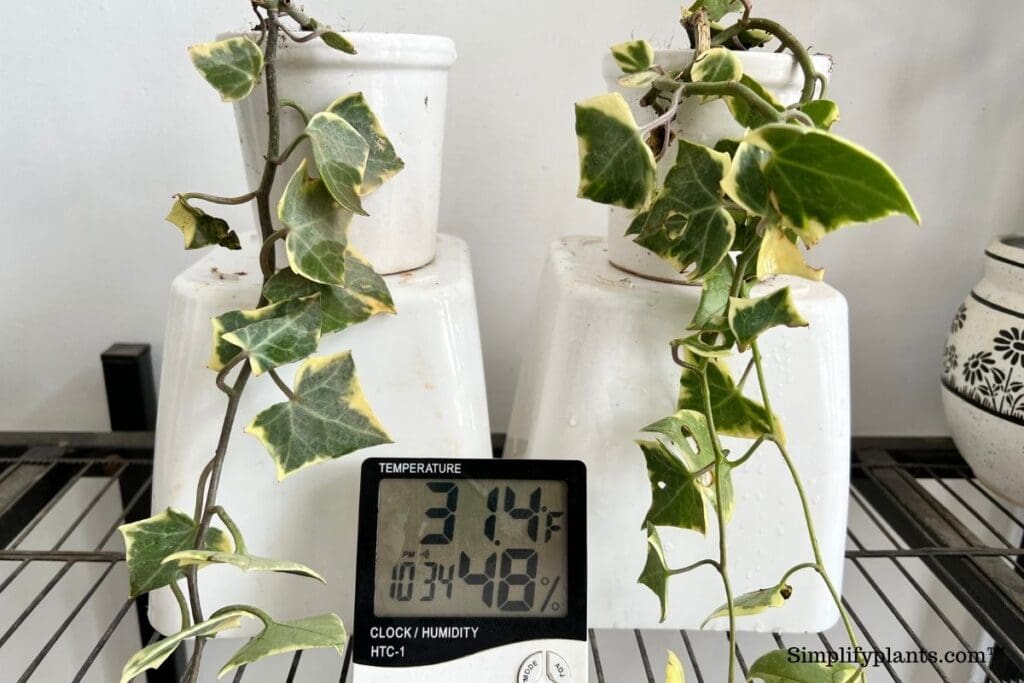
Regarding temperature tolerance, ivies turn out to be hardy plants.
They can tolerate a large range of temperatures, including light frost, for a short period, but if it continues for a long time, your ivy will have issues.
Since ivies come from European regions, they are habituated to growing in slightly cooler climates, unlike tropical plants.
The ideal temperature for their best growth is between 70-90°F.
Though they can tolerate temperatures outside this range, they will not flourish.
If temperatures go below 50°F, the ivy will begin to show signs of stress already.
If your region experiences harsh cold and hard frost, then you must bring your ivy indoors to protect it from cold.
Also, they do not like temperature fluctuations, so keep them away from heating or cooling agents like air conditioners, vents, heaters, coolers, etc.
These tend to stress out the ivies by sucking up their moisture.
| Summers | Winters |
|---|---|
| 1. Protect from high temperatures or direct sun. 2. Provide some shade. 3. Mist the ivy. | 1. Shield from frost. 2. Bring ivy indoors. |
Also read: English Ivy Temperature Tolerance: Ideal Temperature+High/Low Range
English ivy pruning

Pruning is an essential part of the care routine for plants that they may often forget to maintain.
Pruning the ivy is helpful and recommended for multiple reasons.
- Pruning helps keep the ivy look clean and aesthetic.
- Pruning stimulates the hormones of ivy, improving its overall health and growth.
- Pruning eliminates the thin, leggy growth, thus, improving its looks.
If you get an English ivy, you must prune it periodically.
Ivies grow very aggressively and, if not controlled, can get invasive and destroy nearby structures or other plants.
This is why grow English ivies in pots rather than on the ground, as it is easier to restrict their growth in pots.
The best time to prune English ivy is before the start of spring.
In winters, refrain from hard pruning because it puts the plant under a lot of stress, and the ivy finds it harder to recover.
Hard pruning should be done before or during the growing season as the plant remains active and recovers fast.
Another thing to remember is to not prune more than 25% of the plants at a given time, as that would put the ivy under pressure.
Here are some tips for pruning your ivy:
- Always use sharp shears or pruners to prune so that the cuts are clean and do not crush the branches.
- Do not forget to sterilize the pruners before and after use to disinfect them.
- Wear gloves to protect your skin.
- Start by trimming away the dead and yellow parts.
- Then trim off the leggy areas of the ivy.
In short:
- Do not prune more than 25% at a time.
- Hard prune before spring arrives.
- You can light prune several times a year.
Also read: How To Prune English Ivy?
English ivy propagation

After pruning your ivy, what do you do with the healthy parts you have cut?
You can propagate them to get new plants.
Propagation is an easy process that lets you get new plants without spending any money.
These new plants can also be a great gift for your friends and family.
Propagating English ivies is easy through cuttings and can be done in soil and water.
Let me quickly describe the process of propagating your English ivy:
- Choose a healthy part of your ivy for propagation.
- Make sure there are a few nodes in the cutting.
- Even if there are no nodes, we will do without them. Remove the bottom leaves of the cutting. These areas will act as nodes from where new roots will emerge.
In case of water propagation:
- Fill a clean jar with filtered water. Do not use tap water for propagation as it may contain harmful minerals.
- Dip the cutting in some rooting hormone and dip it in the water.
- Change the water every 3-4 days and ensure no leaves touch the water and all the nodes stay submerged.
- Wait until the roots are at least 3-4 inches long, then transplant them to the soil.
In case of soil propagation:
- Fill up a small pot with a light, loose potting mix.
- Plant the cutting in the mix and water it.
- Mist the cutting whenever you see the soil drying, as moist soil helps cuttings to root faster. You can use a plastic bag to lock the moisture.
- Once you see roots wait for some more time until they are bigger, and then move it to a fresh soil mix.
English ivy repotting

Repotting plants can be tricky and, if not done carefully, can shock your plant and permanently kill it.
But don’t you worry.
As long as you know the right way and do it with care, there won’t be a problem.
Ivies are medium growers, and you might need to repot them after every 2-3 years.
Repotting is required when plants get root bound.
This happens when the plant’s growth surpasses that of the pot size and overgrows the pot.
The roots inside begin to suffocate due to the lack of space and airflow.
When this happens, the roots do not get sufficient nutrients and space, hampering the plant’s health.
The ideal time to repot ivies is during the growing season, spring and summer.
Do not repot during winters as the plant will get shocked.
Follow these steps for repotting your English ivy:
- Take the ivy carefully out of the pot.
- Examine the roots well. If there are any rotten roots, prune them off.
- Loosen up the root ball slightly.
- Take a new pot that is 2 inches bigger than the current pot.
- Make soil mix with the ingredients like soil, perlite, and compost.
- Fill 1/3rd of the pot with the soil.
- Place the ivy at the center, then pour soil from all sides.
- Gently tap the pot to close all gaps.
- Water thoroughly, then keep it in a bright spot with loads of indirect light and ventilation.
To summarize:
- Repot in the growing season.
- Repot when the ivy gets root bound.
- Repot the ivy in fresh soil.
- The new pot should not be more than 2 inches bigger.
Also read: How To Repot English Ivy?
English ivy toxicity

English ivies are toxic and can lead to many problems if ingested.
They can lead to complications like diarrhea, hypersalivation, vomiting, and abdominal pain.
If you have children and pets at home, keep the ivy away from their reach.
Pets habitually nibble and play with plants, which might cause serious complications.
So it is best to keep your ivy at places they cannot reach to prevent any risk.
You can keep them in balconies or windows while keeping the panes shut or hang them high up.
Also read: Is English Ivy Poisonous To Pets?
English ivy problems
It sometimes happens that even after we have taken care of our plants, they still show signs of problems.
In such situations, we mostly panic, not understanding what to do.
In the below segment, I will discuss some common problems the English ivy might undergo and their cure.
Yellow leaves

Yellow leaves are a problem that is common and can be caused due to several signs, including:
- Underwatering
- Too much light
- Low light
If you see yellow leaves in your English ivy:
- Prune those off.
- Check if the watering schedule is right.
- If you see the ivy is underwatered, resume watering correctly.
- Fill a tub with water, place the pot in it, and let it soak in as much water as it needs.
- If the sunlight falls on the ivy directly, shift it to a location with a lower intensity of sunlight.
- If your ivy is not getting much light, install artificial lights.
Curling leaves

Leaf curling is another problem that is often seen in ivy plants, signifying a lack of humidity and dehydration.
Leaf curling is an attempt to save moisture loss through the leaves.
Here are some of the solutions to leaf curling:
- If you notice that the leaves of your ivies have curled up, check the humidity levels with a hygrometer.
- Use a humidifier around the ivy to keep the plants hydrated and humid.
- If it’s summer or spring, mist the plant in the mornings to boost humidity and keep it clean.
- Group the ivy with other plants to create a humid zone for them through the process of transpiration.
- Do not use extremely hot or cold water on your plants.
- Keep the ivy away from heaters, vents, air conditions, etc., as they suck up moisture from the leaves.
Falling leaves

Your ivies can drop leaves due to multiple reasons of stress like:
- Pest infestation
- Stress of repotting
- Poor light
- Incorrect watering
The solution to falling leaves is:
- Check the ivy thoroughly to find any sign of pests in the plants.
- If you notice any pests, wash the plant and spray Neem oil or pesticides on your plants.
- Measure the moisture content of the soil with a moisture meter. If you see the soil is overwatered, immediately stop watering and let the soil dry off.
- If you have recently repotted the plant, and the stress of it is causing the leaves to drop, shift it to a better location where it gets bright light and air circulation.
Brown leaves

Some of the most common causes of leaves turning brown are:
- Poor humidity
- Too much sun exposure
- Overfertilization
- Overwatering
Here is what you should follow if you see your ivy getting brown leaves:
- Prune off the brown leaves.
- Cut down watering immediately if you suspect overwatering.
- Do not water unless the top soil is getting dry.
- Do not fertilize plants in winters.
- Check the humidity levels around your plant with the help of a hygrometer.
- If the humidity is below 40%, find a way to increase the humidity. I have mentioned several methods above.
- Move the ivy to a shadier spot if it gets too much light.
Root rot

Root rot is a disease caused by fungus growth in the soil.
One of the most common reasons for root rot is overwatering.
When the soil is saturated with water, oxygen circulation in the root is cut off, so the roots begin to suffocate and can no longer breathe.
In such conditions, rot causes pathogens to invade the roots making them rotten and mushy, which, if not checked, gradually spreads to the entire plant and kills it.
The solution to treat root rot is:
- Take the ivy out of the pot.
- Wash the roots under water and examine them carefully.
- Prune the rotten and mushy roots.
- Spray fungicide over the root ball to prevent further deterioration of the roots.
- Prepare a fresh potting mix.
- Take a new pot if possible. If you do not have that, disinfect the existing pot by soaking it in a solution with 9 parts water and 1 part bleach. This will kill all the germs.
- Repot the pruned plant in this with the fresh soil mix.
- Water thoroughly and let the ivy rest in a bright spot.
Leggy growth

Leggy growth in English ivies is quite common.
Most often, they are caused due to insufficient sunlight.
When the plant does not get sufficient light, it tries to stretch towards the light source.
This results in the plant growing thin and lanky without much foliage growth.
The gaps between the leaves increase.
The best way to treat this is by pruning those leggy areas.
Pruning encourages the branching of the plants by stimulating the growth hormones.
This makes them look fuller and produce more leaves.
Sift the ivy to a spot where it gets more sun exposure.
Rotate your ivy weekly so that the growth on all sides remains even.
White spots
If you notice white spots on your ivy leaves, it may indicate signs of fungal or pest infestations.
Mealybugs, powdery mildew, etc., cause this problem.
- Use Neem oil or insecticidal soap to clear the bugs and move the plant to a well-lit area.
- At the same time, dampness is a leading cause of pests and bugs, so water only when the ivy needs. Remember ivies enjoy slightly drier soil conditions.
- Also, do not keep the plant too crowded together, preventing air flow between them.
Wilting leaves

Wilting of ivies can be due to reasons like watering problems or stress from repotting.
Ensure you are watering the ivy accurately, and in case you are not sure when to water, invest in a moisture meter or do the finger test.
Avoid repotting the ivy during the winter season and ensure not to damage the roots.
English ivy pests
Pest infestations are a major problem that harasses plants and their owners.
English ivies are resistant to most pests but still are not hardy enough to completely repel them.
Some common pests that attack ivies are scales, aphids, mealybugs, spider mites, and thrips.
Pest attack plants that grow in unsuitable conditions.
They are attracted to damp, wet conditions with low light set up and less airflow to disturb them.
Pests like spider mites also attack plants that suffer from dehydration and weakness.
They stick to the body of the plants and gradually suck the nutrients from them, rendering them weak, and if they are not treated on time, they can also kill them.
So in case your ivy gets infested with pests, here is what you need to follow:
- Quarantine the ivy immediately as the bugs spread very quickly.
- Wash the plant thoroughly under nasty water, focusing on the bug-infested spots.
- If some bugs are still attached, prune those areas off.
- Use a solution of 1 tablespoon Neem oil in 1 liter of water. Mix it well, spray it all over the plant generously, and repeat it 3-4 times to clean all bugs.
- You can also mix water, rubbing alcohol, and liquid soap to spray on your plant.
- If the above solutions do not help, you need to resort to chemical pesticides.
Let me tell you a few tips to prevent pest infestations:
- Always keep your ivy in a well-ventilated area.
- Do not keep the plant in a low-light corner.
- Do not keep the soil wet at all times.
- Mist the plants only in the morning so that leaves do not stay wet for a long time.
- Water the plant when the top soil is dry.
Final words
English ivy is a beautiful perennial climbing plant popular for its shiny leaves. Although it doesn’t need much attention, it will need its basic care. I have discussed the care requirements of the English ivy above.
Don’t panic if you find your English ivy experiencing any problem. Try to find the issue and troubleshoot it to rescue the plant.
Reference: Researchgate, University of Tennessee, Mississippi State University, Central Florida Research and Education Center, U.S. DEPARTMENT OF AGRICULTURE.
Recommended Garden Supplies
| Product Image | Our Recommended Gardening Supplies | Check Offers! |
|---|---|---|
Top Top
Top
Top
Top
Top
Top
Top
Top | rePotme Houseplant and Tropical Classic Potting Soil Mix | Check Offer On Amazon |
 Top
Top
Top
Top
Top
Top
Top
Top | Espoma Organic Indoor Plant Food | Check Offer On Amazon |
 Top
Top
Top
Top
Top
Top
Top
Top | GooingTop LED Grow Light 6000K Full Spectrum Clip Plant Growing Lamp | Check Offer On Amazon |
 Top
Top
Top
Top
Top
Top
Top
Top | Soil Moisture Meter | Check Offer On Amazon |
 Top
Top
Top
Top
Top
Top
Top
Top | Govee Hygrometer Thermometer, Bluetooth Enabled! | Check Offer On Amazon |
 Top
Top | LEVOIT Humidifiers for Large Room(Best For Plants) | Check Offer On Amazon |
 Top
Top
Top
Top
Top
Top
Top
Top | Upgraded DIY Automatic Drip Irrigation Kit, 15 Potted Houseplants Support | Check Offer On Amazon |
 Top
Top
Top
Top
Top
Top
Top
Top | Stainless Steel Heavy Duty Gardening Tool Set | Check Offer On Amazon |
 Top
Top
Top
Top
Top
Top
Top
Top | Bonide Insecticidal Soap | Check Offer On Amazon |
 Top
Top
Top
Top
Top
Top
Top
Top | Bonide 32 oz Spray Neem Oil for Organic Gardening | Check Offer On Amazon |
 Top
Top
Top
Top
Top
Top
Top
Top | Garden Safe Fungicide | Check Offer On Amazon |


